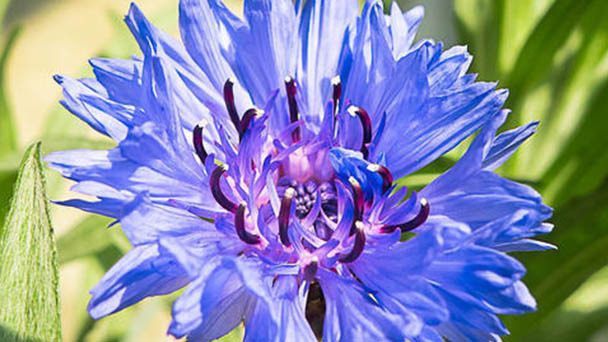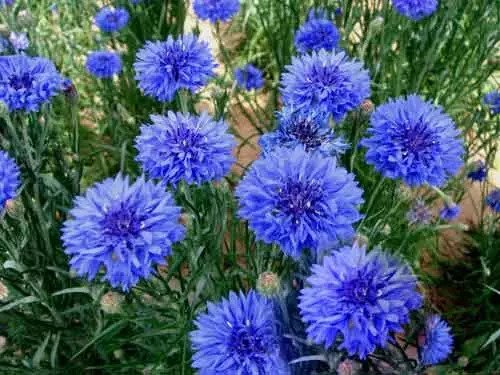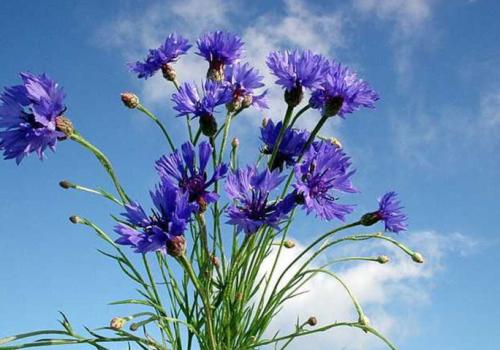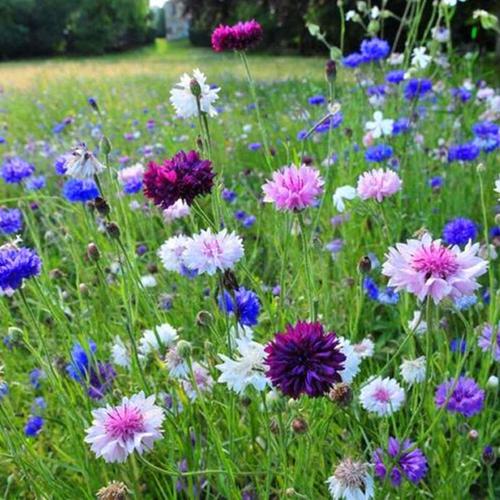Bachelors Button Flower Profile: Plant Facts, Care & Growing Guide
Written by Maggie
Dec 06 2021

Bachelor's Button flower (Centaurea Cyanus L., also called cornflower, is an annual or biennial herb, up to 70 cm tall, erect, branching, grayish stems and branches, basal leaves, top arranged into a corpus or panicle. Involucral bracts of Bachelor's Button are elliptic, discord, blue, white, red, or purple, achenes elliptic.
Bachelor's Buttons flower hometown is in Europe. It was a kind of wild flowers, after many years of cultivation, its "wild" sex is less, the flowers become bigger, the color becomes more, there are purple, blue, light red, white and other varieties, among which purple, blue is the most expensive. Bachelor's Button can be found everywhere in Germany, on hillsides, in fields, by water, on roadsides, in front of houses and behind houses. It is regarded as the national flower in Germany.
Bachelor's button flower is not only an ornamental plant, but also a good nectar source plant. Edge flowers can be diuretic, the whole grass extract can brighten the eyes. The oil content of achene is 28%.
Bachelor's Button Flower Picture

Bachelor's Button Flower Info
| Botanical Name | Centaurea cyanus |
| Common Names | Bachelor's Button flower, annual cornflower |
| Plant Type | Flowering annual |
| Mature Size | 12–48 inches tall, 10–12 inches wide |
| Natural Range | Europe |
| Bloom Time | Spring Bloom, Fall Bloom, Summer Bloom |
| Sun | Full sun to part shade |
| Toxicity | None |
| Flower | Blue, purple, pink, or white |
Bachelor's Button Plant Characteristics
Bachelor's Button Stems
Bachelor's button plant is an annual or biennial herb, 30-70 cm or more tall, erect, branched from the middle, rarely unbranched. All stem branches of Bachelor's Button are gray white, by thin spider filamentous curly hair. Basal leaf and lower stem leaves are long elliptical oblanceolate or lanceolate, not divided, edge no serrate or entire margin sparsely serrate to split the big feather, lateral lobes 1-3, long elliptic-lanceolate, linear lanceolate or linear, margin entire without jagged, lobes larger, long elliptical oblanceolate or lanceolate, small serrated edge.
Bachelor's Button Leaves
Bachelor's Button leaves are linear, wide linear or linear lanceolate, 4-9 cm long, 4-8 mm wide, acuminate at the top, cuneate at the base, no petiole edge without serrate, the upper stem and leaves and central stem and leaves homomorphic form, but gradually smaller. All the two sides of the stem and leaves of Bachelor's Button are heterochromatic or nearly heterochromatic, green or grayish green above, by sparse spider silk hair or depilate, below grayish white, by thin villi.
Bachelor's Button Flowers
The head of most or a few Bachelor's Button flowers at the top of the stem branches are arranged in a corymus or panicle. Involucral bracts are elliptic, 1-1.5 cm in diam., sparsely silky. Involucral bracts of Bachelor's Button are about 7 layers, all involucral bracts elliptic from outside to inside, long elliptic, outer and middle layers including apical appendage 3 -- 6 mm long, 2 -- 4 mm wide, inner layers including apical appendage 1 -- 11 cm long, 3 -- 4 mm wide. All bracts have pale brown or white appendages apically, larger middle and outer appendages, larger inner appendages, all appendages extending short along the bracts, margin fimbriate serrate.
Bachelor's Button Fruit
Bachelor's Button achene-oval, 3 mm long and 1.5 mm wide, pinstriped, covered with sparse white pubescent hairs. Crest is white or light earth-red, 2 rows, outer row multiplayer, gradually lengthened to the inner layer, up to 3 mm, inner row 1 layer, very short; All crown hairs are rigid and hairy.
Bachelor's Button Plant Habits
Bachelor's Button adaptability is strong, like full of sunshine, can not tolerate dampness, must be planted in a sunny, good drainage place, otherwise often due to damp and lead to death. Bachelor's Button flower prefers fertile, loose and well-drained sandy soil.
Bachelor's Button Care
Bachelor's Button Seedling
Choose loose fertile soil as a bed, covered with soil about 0.2 cm, cultivation: to be seedlings of the leaf hair to 6-7 transplantation, potted every 13-17 cm pot plant a Bachelor's Button. After the Bachelor's Button seedlings are colonized and survive, the heart should be picked once to promote more branching and more flowering. On the contrary, if there is too much branching, part of the side buds should be picked when necessary to obtain larger flowers. Because of the rhizosphere, it is appropriate to live autumn sowing to cover overwintering, flowering in early summer, such as cold bed overwintering can blossom in late spring, spring sowing should be sown as early as possible.
Bachelor's Button due to the origin of the European field, so slightly cold, like cool and sunny places.
Bachelor's Button Soil
Loose, fertile, sandy loam with good drainage is preferred. Cultivation soil should try to make its drainage and ventilation good, if the soil viscosity is heavy, it can be mixed with 3-40% of snake sawdust or pearl stone to improve.
Bachelor's Button Watering
Watering in principle once a day is enough, but the summer is more arid, but morning and evening each poured once, in order to keep the basin soil moist and reduce the temperature of potting, but avoid water.
Bachelor's Button Fertilizer
Bachelor's Button flower likes more fertilizer, fertility should be applied every month three elements of diluent once. If the leaves are too luxuriant, the proportion of nitrogen fertilizer should be reduced, and more phosphate and potassium fertilizer should be applied before flowering, so as to get larger and beautiful flowers.
Bachelor's Button Flowering Care
Bachelor's Button plant can naturally issue side branches, side branches are more small flowers, if necessary, you can pick part of the side bud, leaving only small branches, you can get larger flowers. Bachelor's Button is a long-day plant. The sunshine time is short in winter. If the plant lamp is used for supplementary illumination at night, it can make the flowering earlier.
Bachelor's Button Pruning
Bachelor's Button plant is a low-maintenance plant. Once established, barring an especially dry spell, it is self-sufficient.Weed regularly to maintain adequate airflow between plants, and inhibit fungal growth and insect infestation. Add a layer of mulch to aid in water retention and weed control.
If the spreading of plants is a concern, deadheads spend flowers as they finish blooming, to limit self-seeding.
You may also mow down the entire garden before flowers set seed. Just make sure to clear away the cuttings before they dry out!
On the other hand, if you’re a fan of spreading cornflowers, save the seeds per the instructions below, to plant next season or share with friends.
Taller varieties may benefit from staking to keep leggy plants from looking weedy.
You may prune plants by one-third mid-season to rejuvenate them and reduce legginess. However, if you like to cut stems for bouquets, let them grow tall and stake as needed.
Bachelor's Button Plant Propagation
Bachelor's Button flower grows from seed sown directly into the garden. As it is a cool-weather hardy annual, there is no need to start seeds indoors. You may do so, but as plants do not take well to transplanting, it is not advised.
In warmer regions, where the ground doesn’t freeze, you may sow seeds in the fall.
In cooler areas that experience freezing temperatures, it’s best to plant in late winter or early spring, once the ground has thawed and become workable.

Bachelor's Button Flower Disease & Pest
- Sclerotinia
The pathogen was discobacterium nucleotide. The disease mainly harm the base of the Bachelor's Button stem, in the case of higher temperature, the stem often appear water stain light brown spots, serious disease becomes gray, after the tissue decay, the Bachelor's Button upper stem and leaves withered, the disease in spring and autumn the environmental temperature of 15℃ or so under the humid conditions most prone to occur.
Avoid overplanting; Diseased plants are immediately pulled out and burned. In severe cases, the middle and lower parts of the Bachelor's Button can be sprayed with 70% topbucine WP 1000 times.
- Downy mildew
The affected leaves appear irregular light grey-green to light red lesions, and the lesions on the back of the leaves are covered with downy mildew, resulting in leaf death.
- Pathogen
The fungus is Bremial actucaeregel, belonging to the subphylum flagellum, class oomycetes, order downy mildew, genus trichoderma.
The pathogen overwinters in the diseased tissue with oospores. In the second year, oospores germinate and produce germ tubes for infection. Young Bachelor's Buttons are prone to disease.High humidity is conducive to disease.
(1) Pull out the diseased plant in time and concentrate on treatment.
(2) the plant planting but dense, maintain good ventilation and light conditions.
(3) pharmaceutical prevention and control: when the disease, can be sprayed 1:1:100 Bordeaux liquid, or 65% of the Zinc Wet Powder 500-800 times the liquid, or 25% of the Ruitu mold 800-1000 times the liquid, or 40% of the ethylphosphor aluminum 200-300 times the liquid and other pharmaceutical prevention and control.
- Pathogen
The pathogen was Artichokecurlydwarfvirus. The passivation temperature of the virus was 55-60℃, the dilution limit was 0.00001-0.001, and the virus protection period was 2-3 days in vitro.
The virus was infected by contact with SAP, and no transmission vector was found. The virus hosts a wide range, in addition to Bachelor's Button, the virus can also infect cabbage thistle, Jerusalem artichoke, sunflower and zinnia grass and so on. There are chlorotic spots on sunflowers with pale brown necrotic margins. Partial dead spots appear on Zinnia chinensis. The pattern of the disease is unclear.
① Diseased plants should be removed immediately and destroyed centrally.
② in the gardening operation, try to avoid contact with the juice infection, hands and tools should be disinfected
Bachelor's Button Flower Distribution
Bachelor's Button flower is mainly distributed in Europe, the former Soviet Union (Caucasus and Central Asia, Siberia and the Far East), North America and so on.
Bachelor's Button flower in China is mainly distributed in Xinjiang, Qinghai, Gansu, Shaanxi, Hebei, Shandong, Jiangsu, Hubei, Guangdong and Xizang all over the park, garden and campus common cultivation, for viewing.Xinjiang, Qinghai may have naturalized escape.
The model specimens of Bachelor's Button are collected from Europe.
Bachelor's Button Plant Uses
- Garden Use
Bachelor's button plants tall and straight, pedicel long, suitable for cut flowers, can also be used as flower diameter material. The short plant is only 20 cm high, can be used for flower beds, grass edge or potted flower ornamental. Large areas of natural vegetation. High - type varieties can be arranged in accordance with other grass flower beds and flower borders. Bachelor's Button can also be planted along the road or on the lawn, with elegant plants and beautiful flowers. It is very natural. Bachelor's Button Can also cut flowers.
Bachelor's Button plant can improve the appearance, relax the mood, help digestion, and make urine flow smoothly. Bachelor's Button pure dew is a very mild natural skin cleanser, flower water can be used to maintain hair and moisturize skin; Aids digestion and relieves rheumatic pain. Bachelor's Button helps to treat stomachache, prevent and cure gastritis, gastrointestinal discomfort, bronchitis. It is a flower that is not afraid of heat and cold, so it is difficult to grow it well in summer in Taiwan, except in high and cold areas.
-
Tea
Single brew, suitable with green tea. Take 4 teaspoons of Bachelor's Button and soak it with boiling water. The tea juice of lavender, can add a few honey to add flavor more.
Bachelor's Button Flower Poison
The whole plant is slightly toxic. If eating a large amount, it will cause hind limb paralysis, and have inappetence, diarrhea and other phenomena.
Bachelor's Button Varieties
Most people are drawn to the vibrant blue of Bachelor's Buttons flower, but why not explore other options with this easy annual?
'Blue boy' has flowers that are a vivid periwinkle blue.
'Tall Double Mixed' series offers plants in shades of white, pink, and blue.
'Blackball' is a rare variety with flowers featuring deep crimson poms.
'Dwarf Blue Midget' begins blooming when plants 6 inches and top out at 12 inches, making it excellent for containers.
'Burgundy Beauties Mix' includes plants producing three types of blooms: burgundy-white bicolor flowers, solid burgundy flowers, and burgundy flowers with white tips.

Read Next:
Top 10 Most Beautiful Roses in the World
Top 10 Most Beautiful Flowers in the World
26 Best Autumn Flowers to Plant for Fall Color in Garden
Latest Updated
- Benefits of Bugleweed - 7 Science-backed Health Benefits
- Bugleweed Dangers & Side Effects - Is It Poisonous?
- How to Plant Evergreen Trees - What You Should Know
- When to Plant Evergreens - Grow Guide for Evergreen Trees
- 12 Wonderful Evergreen Shrubs for Your Garden
- 12 Popular Evergreen Plants with Pictures for Beginners
- When And How To Prune A Lilac Bush Like a Pro
- How to Grow & Care for Lilac Vine (Hardenbergia Violacea)
- Japanese Lilac Tree (Syringa Reticulata) Care & Propagation Guide
- Shumard Oak Pros and Cons - What to Know
Popular Articles
- Winter maintenance of Antirrhinum Majus
- How to Grow Terminalia Mantaly Tree
- How to Grow and Care for Crossostephium Chinense
- How to grow Antirrhinum Majus in spring
- Peristeria Elata (Dove Orchid) Profile: Info & Care Guide
- Underwatered Snake Plant (Sansevieria Trifasciata) - Signs And How To Fix
- How to Care for Brazilian Jasmine Plant (Mandevilla Sanderi)
- How to Grow & Care for Graptopetalum Purple Delight in Summer
- Rosa Chinensis (China Rose): Plant Growing & Care Tips
- How to Care for Baby Sun Rose (Aptenia Cordifolia)